外研版(2019)选择性必修 第三册Unit2 A life’s work Understanding ideas 课件(共33张PPT)
文档属性
| 名称 | 外研版(2019)选择性必修 第三册Unit2 A life’s work Understanding ideas 课件(共33张PPT) | 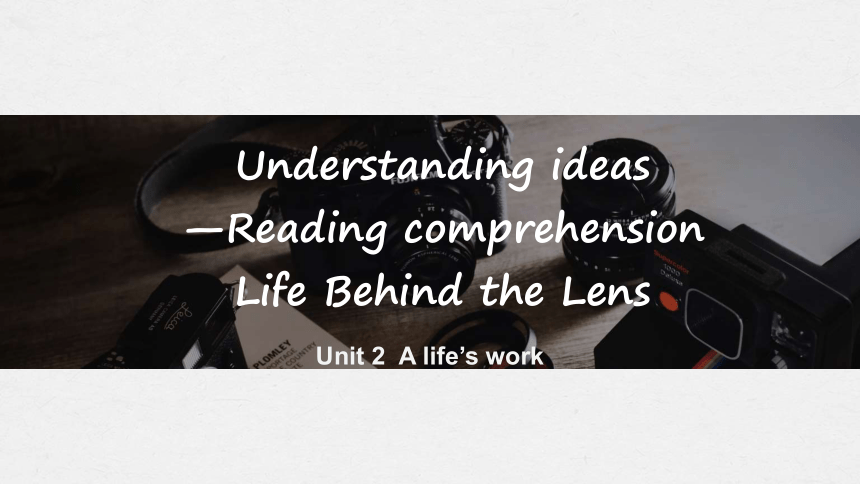 | |
| 格式 | pptx | ||
| 文件大小 | 22.0MB | ||
| 资源类型 | 教案 | ||
| 版本资源 | 外研版(2019) | ||
| 科目 | 英语 | ||
| 更新时间 | 2024-04-04 20:17:03 | ||
图片预览

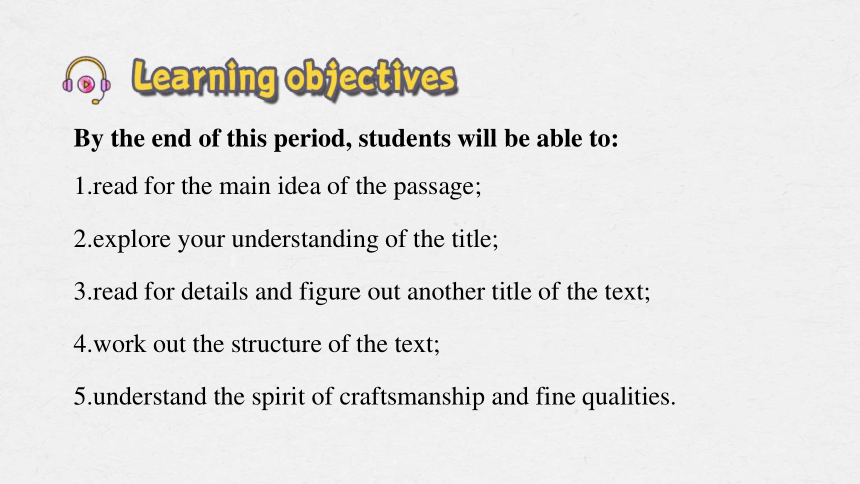
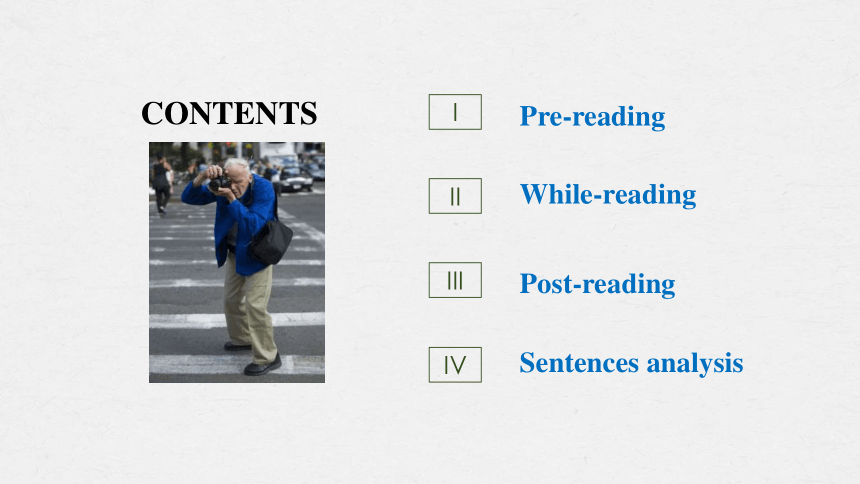
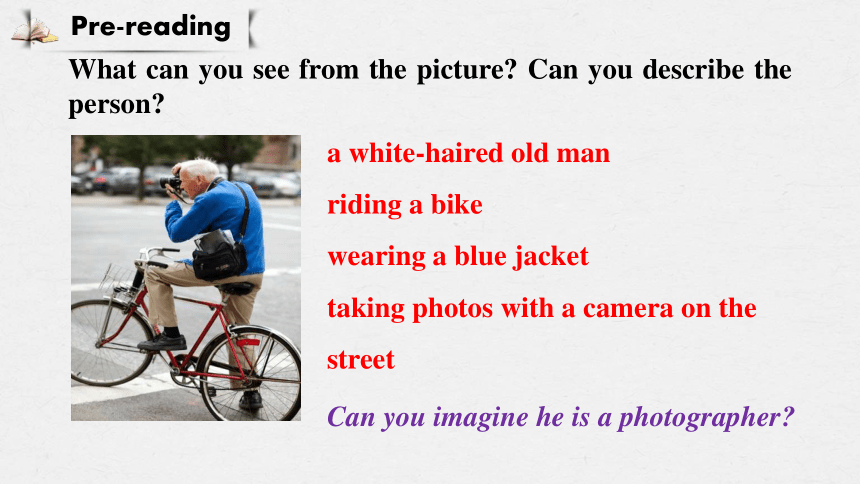
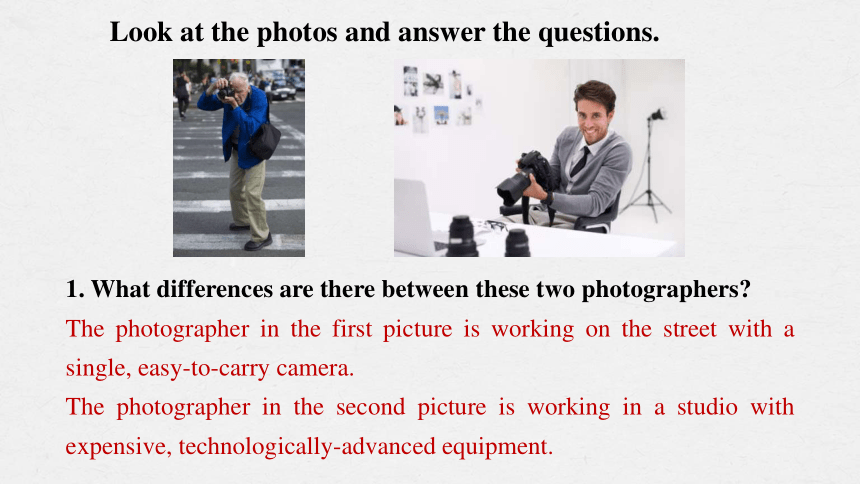
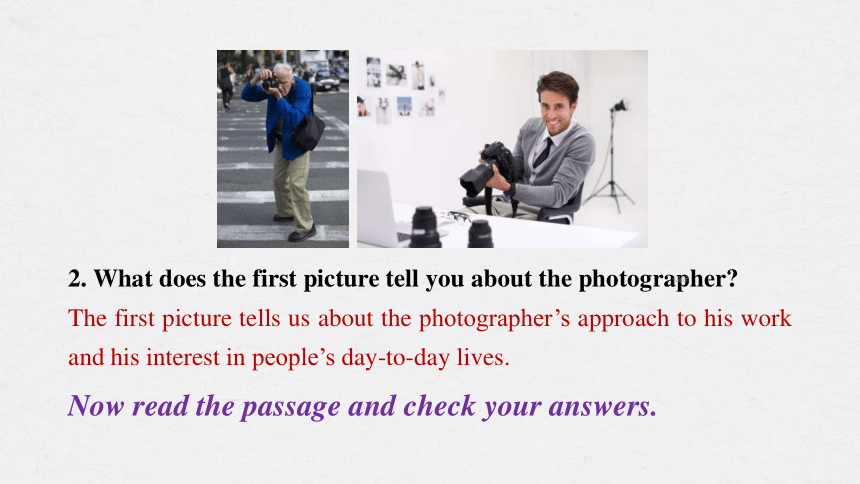
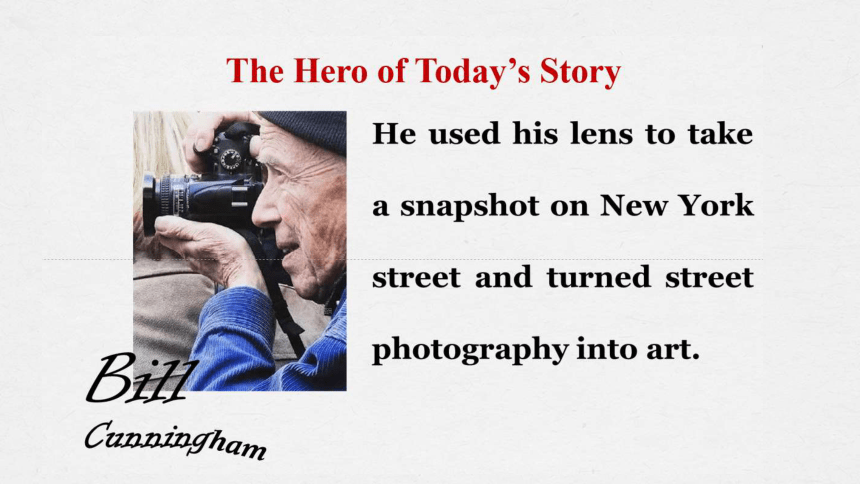
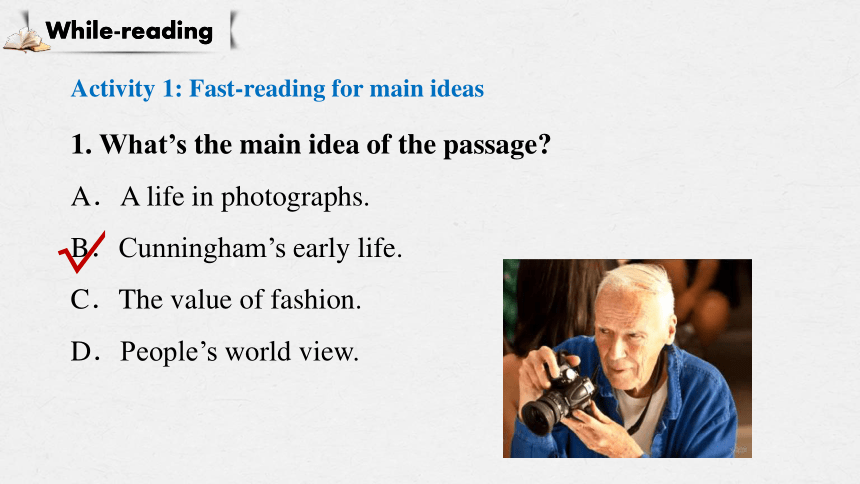
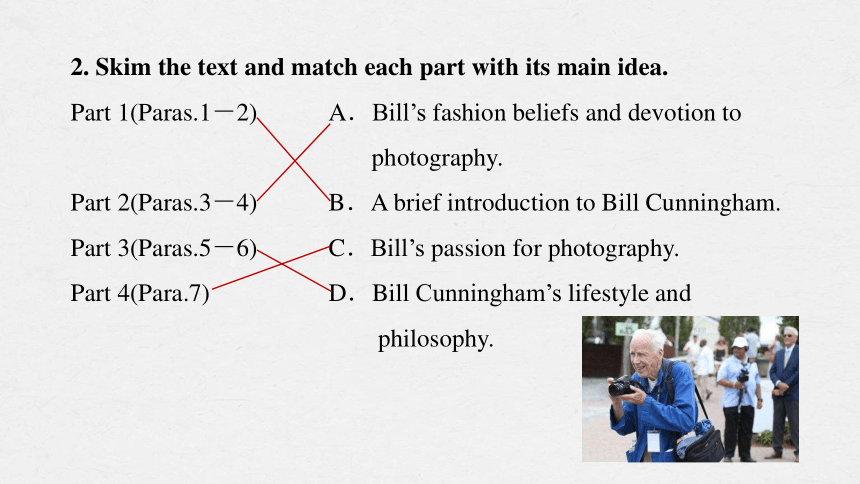
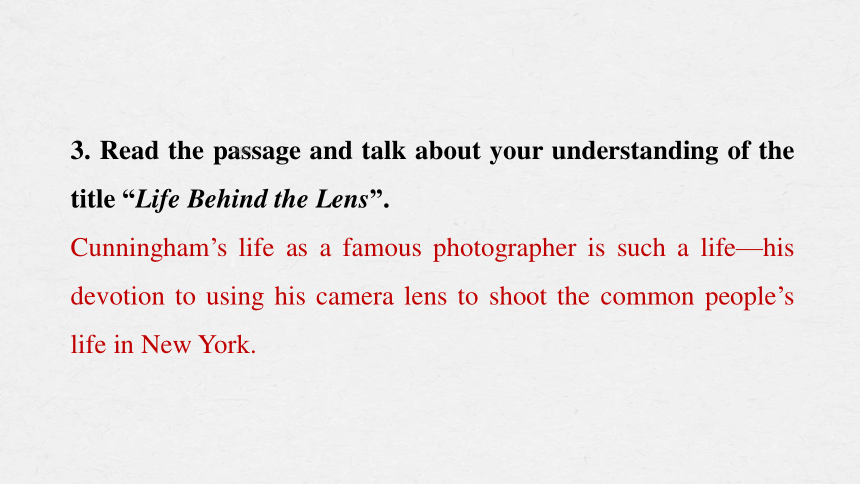
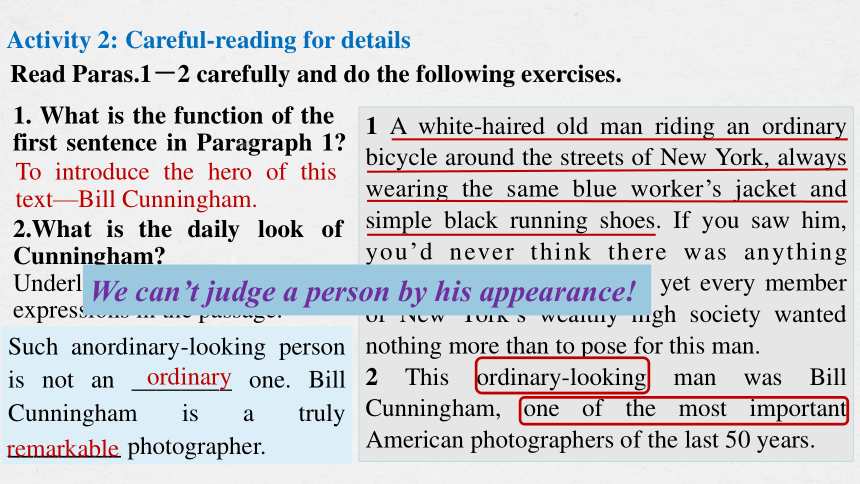
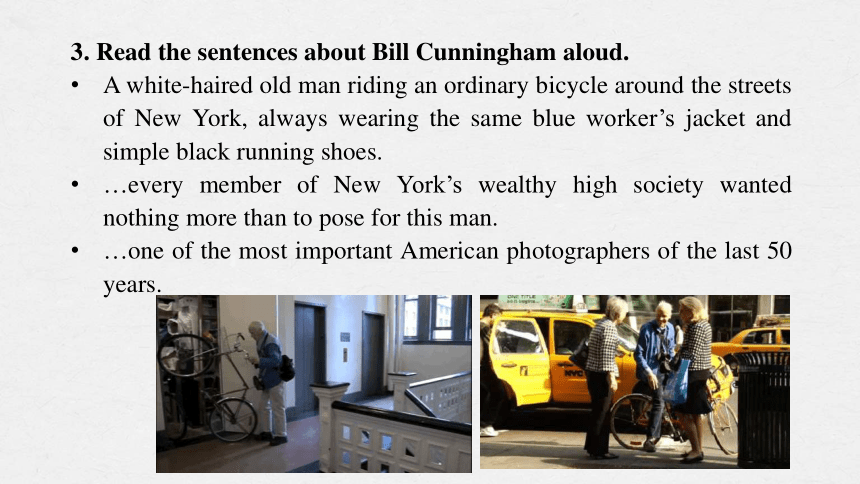
文档简介
(共33张PPT)
Understanding ideas
—Reading comprehension
Life Behind the Lens
Unit 2 A life’s work
By the end of this period, students will be able to:
1.read for the main idea of the passage;
2.explore your understanding of the title;
3.read for details and figure out another title of the text;
4.work out the structure of the text;
5.understand the spirit of craftsmanship and fine qualities.
CONTENTS
Pre-reading
I
While-reading
II
Post-reading
III
Sentences analysis
IV
What can you see from the picture Can you describe the person
a white-haired old man
riding a bike
wearing a blue jacket
taking photos with a camera on the street
Can you imagine he is a photographer
Pre-reading
1. What differences are there between these two photographers
The photographer in the first picture is working on the street with a single, easy-to-carry camera.
The photographer in the second picture is working in a studio with expensive, technologically-advanced equipment.
Look at the photos and answer the questions.
2. What does the first picture tell you about the photographer
The first picture tells us about the photographer’s approach to his work and his interest in people’s day-to-day lives.
Now read the passage and check your answers.
While-reading
While-reading
1. What’s the main idea of the passage
A.A life in photographs.
B.Cunningham’s early life.
C.The value of fashion.
D.People’s world view.
√
Activity 1: Fast-reading for main ideas
2. Skim the text and match each part with its main idea.
Part 1(Paras.1-2) A.Bill’s fashion beliefs and devotion to
photography.
Part 2(Paras.3-4) B.A brief introduction to Bill Cunningham.
Part 3(Paras.5-6) C.Bill’s passion for photography.
Part 4(Para.7) D.Bill Cunningham’s lifestyle and
philosophy.
3. Read the passage and talk about your understanding of the title “Life Behind the Lens”.
Cunningham’s life as a famous photographer is such a life—his devotion to using his camera lens to shoot the common people’s life in New York.
1. What is the function of the first sentence in Paragraph 1
Read Paras.1-2 carefully and do the following exercises.
1 A white-haired old man riding an ordinary bicycle around the streets of New York, always wearing the same blue worker’s jacket and simple black running shoes. If you saw him, you’d never think there was anything remarkable about him. And yet every member of New York’s wealthy high society wanted nothing more than to pose for this man.
2 This ordinary-looking man was Bill Cunningham, one of the most important American photographers of the last 50 years.
2.What is the daily look of Cunningham
Underline the words and expressions in the passage.
Activity 2: Careful-reading for details
Such anordinary-looking person is not an ________ one. Bill Cunningham is a truly _________ photographer.
ordinary
remarkable
We can’t judge a person by his appearance!
To introduce the hero of this text—Bill Cunningham.
3. Read the sentences about Bill Cunningham aloud.
A white-haired old man riding an ordinary bicycle around the streets of New York, always wearing the same blue worker’s jacket and simple black running shoes.
…every member of New York’s wealthy high society wanted nothing more than to pose for this man.
…one of the most important American photographers of the last 50 years.
1.Organize information from the passage and complete the diagram.
Beliefs about fashion(Para.3) Fashion is not restricted to(1)___________________________.
It belongs to (2)__________.
It is about what people are wearing, not (3)____________.
Fashion is not equal to luxury.
Devotion to photography (Para. 4) Regardless of the weather, Cunningham would (4)_______________________________________________.
He wouldn’t come back until (5)_______________________________.
He hardly ever (6)____________________________________________.
high society and big brands
the people
who they are
go out onto the streets of New York each and every day
he knew he had the right photos
took a day off and not once stayed home sick
Read Paras.3-4 carefully and do the following exercises.
2.What made Cunningham so great
A. His ordinary-looking appearance.
B. His inspiration from ordinary scenes and his hard work.
C. Years of experience in fashion photography.
D. Years of simple life and ability of searching for fun.
3.What does Cunningham think of fashion
A. High society is the source of fashion.
B The celebrities are the symbol of fashion.
C. Everyone can enjoy the beauty of fashion.
D. Big brands tend to be fashionable.
√
√
4.Which of the following statements is TRUE according to the third paragraph
A.Cunningham used expensive cameras to take photos.
B.Cunningham only photographed celebrities.
C.Cunningham could find inspiration from common scenes.
D.Cunningham thought fashion belonged to wealthy people.
Fill in the blanks and read the sentences according to the passage.
He found __________ where others could not, in simple, everyday ______, such as a man ______ oranges at the local grocery store, or a woman ________ home on the graffiti-covered subway.
inspiration
scenes
buying
riding
He preferred to photo real, ordinary people in simple, everyday scene.
√
1.Organize information from the passage and complete the diagram.
Life philosophy
Cunningham lived in (1)____________________________________________.
He ate (2)_________________________________________.
He never accepted (3)_______________________________________________________________.
He valued (4)________________________________________________.
a small apartment with a shared washroom
the same meal of sausages, eggs and coffee
the benefits offered to him for being a fashion photographer
his integrity and would not be bought by anyone
Read Paras. 5-6 and do the following exercises.
Cunningham never accepted the benefits offered to him for being a fashion photographer. He valued his integrity and would not be bought by anyone, no matter how many free clothes or flights to faraway destinations he was offered. And if he went to a celebrity party, he was there to work rather than have fun. “Money’s the cheapest thing,” he once said, then added: “... freedom is the most expensive.” This lack of self-interest and promotion kept Cunningham focused on his craft, enabling him to capture New York’s unique street style.
2.What’s your understanding of Cunningham’s words “Money’s the cheapest thing”?
A.He cares little about money.
B.He can buy the cheapest things.
C.He prefers money to freedom.
D.He considers his craft worthless.
3.The underlined sentences show Bill Cunningham’s different________ between money and freedom of creation.
attitudes
√
4. What kept Cunningham focused on his craft
A. The good profit.
B. The love from high society.
C. The lack of self-interest and promotion.
D. The trouble of simple life.
self-interest n.利己主义
√
Bill Cunningham’s
Working
Background Information
Shunning material wealth (精简物质财富) throughout his long and successful life, Cunningham’s philosophy (人生哲学) was “If you don’t take their money, they can’t tell you what to do, kid.”
1. What do we know about Cunningham from the last paragraph
A.He didn’t stop taking photos until he died.
B.He was fond of taking photos all his life.
C.He wanted to be one of the observed.
D.He was more a cultural anthropologist than a fashion photographer.
2.Why is Bill Cunningham called a “cultural anthropologist”?
A.He reflected his culture in photography.
B.He focused on people in his photos.
C.He was interested in the photography culture.
D.He recorded the life of a whole city and its people over half a century.
Read Para. 7 and do the following exercises.
√
√
cultural anthropologist
adj. 文化人类学家
Bill Cunningham was an observer, and not one of the observed, a worker not a star—and this was how he wanted it.
Bill Cunningham chose to work in his own way, observing others instead of being observed. He was a worker behind the camera, not a star in front of it.
3.How do you understand this sentence
4.What rhetorical device (修辞手法) does the author use in this sentence
A.Metaphor(隐喻). B.Personification(拟人).
C.Hyperbole(夸张). D.Antithesis(对比).
√
1. What tags did Bill Cunningham enjoy about his whole life
A fashion photographer, a cultural anthropologist, an observer, a worker.
Read the whole passage and do the following exercises.
2.Choose another suitable title for the passage.
A.Social Butterfly B.Art and Devotion
C.Follower of Fashion D.A Life in Photographs
√
3.What made Bill such a successful photographer
A.His fashion beliefs B. His devotion to photography
C.His life philosophy. D. All of the above.
√
4.Now come up with words or expressions to describe Bill Cunningham.
principled
be of integrity
devoted / dedicated
hard-working
skillful
passionate
…
unworldly(淡没金钱的)
live simple and modestly
Post-reading
1. Why is Bill Cunningham called a “cultural anthropologist”?(Critical thinking)
Bill Cunningham is called a “cultural anthropologist” because his photography captured and created an everlasting record of the life of New York and its people over half a century.
Activity 1: Discussion
2.What can you learn from Bill Cunningham (Creative thinking)
We can learn his spirit of craftsmanship and fine qualities:
Be a person with a fun soul.
Find work you love and work hard for it.
Be full of devotion to your career and passion for your work.
Value your integrity and care little about fame and wealth.
Find some inspiration for your life and enjoyment of beauty.
Advocate and practice a simple life.
Bill Cunningham was an ordinary-looking man and one of the 1._____________(important) American photographers of the last 50 years. He always used simple, 2.__________(relative) cheap cameras and took all his pictures on the streets of New York. He would like 3._____________(photograph) ordinary people as much as VIPs and found inspiration 4._____ others could not, in simple, everyday scenes. These scenes were real and Cunningham could see beauty and potential within their reality. In addition, Cunningham was devoted 5.__ photography. He would even stay outside in a storm, not 6.________(come) back until he knew he had the right photos. This devotion and hard work can 7.____________(reflect) within his photos. Although he was world-famous, Cunningham lived a simple life and never accepted the benefits 8._______(offer) to him. He thought “Money is the cheapest thing,” and “Freedom is the most expensive.” At the age of 87 he passed away and had been working right up until his last illness. His hard work made him more than 9.___ fashion photographer. He was an 10.________(observe), and not one of the observed, a worker not a star and this was how he wanted it.
most important
relatively
to photograph
where
to
be reflected
offered
coming
a
Activity 2: Summary
observer
Sentences Analysis:
1.These things were real, and it was within their reality that Cunningham saw both beauty and potential.
[句式分析] 该句是and连接的______句;it was within their reality that ...含有________句式,其基本句式构成为____________________________________________________。
[自主翻译]
并列
强调
这些东西是真实的,在这种真实中,坎宁安看到了美好和潜力。
It is/was +被强调部分+that(强调人也可用who)从句
2.Through his fascination with what people were wearing, and not who they were, he opened the doors of fashion to everyone—fashion as he saw it belonged to the people, not just to high society and big brands. [句式分析] 此句是_________句。主干为 __________ 的句子,第一个逗号前面为介词短语作__________,其中with后面是what和who引导的两个并列的________从句;as he saw it为as引导的___________从句,在句中作插入语。
[自主翻译]
主从复合
宾语
方式状语
他用自己迷恋的对象——关注人们穿什么,而不是
方式状语
主谓宾状
这些人是谁——向所有人打开了时尚的大门。在他看来,时尚属于民众,而不仅仅属于上流社会和大品牌。
3.Moreover, what made Cunningham great was his devotion to photography, and the hours and hours of sheer hard work he put into his work.
[句式分析] 此句是_________句。主句为_________结构;what引导_______从句;was后的成分为_________;he put into his work为省略了which/that 的________从句,修饰the hours and hours of sheer hard work。
[自主翻译]
主从复合
主系表
定语
此外,坎宁安的伟大之处还在于他对摄影的奉献精神,
主语
表语
以及他在工作中投入的大量时间和精力。
4. He valued his integrity and would not be bought by anyone, no matter how many free clothes or flights to faraway destinations he was offered.
[句式分析] 此句是_________句。主句为:_____;no matter how引导的是___________从句;he was offered是省略that或which的________从句。
[自主翻译]
让步状语
他珍视自己的正直,不为任何人所动摇,无论提供给他
定语
主从复合
多少免费衣物或远程航班。
5. This lack of self-interest and promotion kept Cunningham focused on his craft, enabling him to capture New York’s unique street style. [句式分析] 此句为_______句。主干为____________结构,This lack of self-interest and promotion 作句子的______,_____为谓语,Cunningham 为_________,focused on his craft为过去分词短语作____________,enabling him to...为现在分词短语作__________。
[自主翻译]
主谓宾宾补
宾语
宾语补足语
对自身利益和升迁毫不关注,这使坎宁安能够专注于
kept
结果状语
主语
简单
自己的技能,捕捉到纽约独特的街头风格。
6. His hard work made him more than a fashion photographer—he was a “cultural anthropologist”, who we can thank for recording the life of a whole city and its people over half a century.
[句式分析] 此句是_________句。more than a fashion photographer 是名词短语作_____________;破折号后面he was a “cultural anthropologist”作前面名词a fashion photographer的_______;其中who引导___________________。
[自主翻译]
主从复合
宾语补足语
同位语
他的辛勤工作使他不仅是一名时尚摄影师——他更是
非限制性定语从句
一位“文化人类学家”,我们感谢他记录了整个城市及其人民长达半个世纪的生活。
Homework
Review what we have learnt and preview language points.
Understanding ideas
—Reading comprehension
Life Behind the Lens
Unit 2 A life’s work
By the end of this period, students will be able to:
1.read for the main idea of the passage;
2.explore your understanding of the title;
3.read for details and figure out another title of the text;
4.work out the structure of the text;
5.understand the spirit of craftsmanship and fine qualities.
CONTENTS
Pre-reading
I
While-reading
II
Post-reading
III
Sentences analysis
IV
What can you see from the picture Can you describe the person
a white-haired old man
riding a bike
wearing a blue jacket
taking photos with a camera on the street
Can you imagine he is a photographer
Pre-reading
1. What differences are there between these two photographers
The photographer in the first picture is working on the street with a single, easy-to-carry camera.
The photographer in the second picture is working in a studio with expensive, technologically-advanced equipment.
Look at the photos and answer the questions.
2. What does the first picture tell you about the photographer
The first picture tells us about the photographer’s approach to his work and his interest in people’s day-to-day lives.
Now read the passage and check your answers.
While-reading
While-reading
1. What’s the main idea of the passage
A.A life in photographs.
B.Cunningham’s early life.
C.The value of fashion.
D.People’s world view.
√
Activity 1: Fast-reading for main ideas
2. Skim the text and match each part with its main idea.
Part 1(Paras.1-2) A.Bill’s fashion beliefs and devotion to
photography.
Part 2(Paras.3-4) B.A brief introduction to Bill Cunningham.
Part 3(Paras.5-6) C.Bill’s passion for photography.
Part 4(Para.7) D.Bill Cunningham’s lifestyle and
philosophy.
3. Read the passage and talk about your understanding of the title “Life Behind the Lens”.
Cunningham’s life as a famous photographer is such a life—his devotion to using his camera lens to shoot the common people’s life in New York.
1. What is the function of the first sentence in Paragraph 1
Read Paras.1-2 carefully and do the following exercises.
1 A white-haired old man riding an ordinary bicycle around the streets of New York, always wearing the same blue worker’s jacket and simple black running shoes. If you saw him, you’d never think there was anything remarkable about him. And yet every member of New York’s wealthy high society wanted nothing more than to pose for this man.
2 This ordinary-looking man was Bill Cunningham, one of the most important American photographers of the last 50 years.
2.What is the daily look of Cunningham
Underline the words and expressions in the passage.
Activity 2: Careful-reading for details
Such anordinary-looking person is not an ________ one. Bill Cunningham is a truly _________ photographer.
ordinary
remarkable
We can’t judge a person by his appearance!
To introduce the hero of this text—Bill Cunningham.
3. Read the sentences about Bill Cunningham aloud.
A white-haired old man riding an ordinary bicycle around the streets of New York, always wearing the same blue worker’s jacket and simple black running shoes.
…every member of New York’s wealthy high society wanted nothing more than to pose for this man.
…one of the most important American photographers of the last 50 years.
1.Organize information from the passage and complete the diagram.
Beliefs about fashion(Para.3) Fashion is not restricted to(1)___________________________.
It belongs to (2)__________.
It is about what people are wearing, not (3)____________.
Fashion is not equal to luxury.
Devotion to photography (Para. 4) Regardless of the weather, Cunningham would (4)_______________________________________________.
He wouldn’t come back until (5)_______________________________.
He hardly ever (6)____________________________________________.
high society and big brands
the people
who they are
go out onto the streets of New York each and every day
he knew he had the right photos
took a day off and not once stayed home sick
Read Paras.3-4 carefully and do the following exercises.
2.What made Cunningham so great
A. His ordinary-looking appearance.
B. His inspiration from ordinary scenes and his hard work.
C. Years of experience in fashion photography.
D. Years of simple life and ability of searching for fun.
3.What does Cunningham think of fashion
A. High society is the source of fashion.
B The celebrities are the symbol of fashion.
C. Everyone can enjoy the beauty of fashion.
D. Big brands tend to be fashionable.
√
√
4.Which of the following statements is TRUE according to the third paragraph
A.Cunningham used expensive cameras to take photos.
B.Cunningham only photographed celebrities.
C.Cunningham could find inspiration from common scenes.
D.Cunningham thought fashion belonged to wealthy people.
Fill in the blanks and read the sentences according to the passage.
He found __________ where others could not, in simple, everyday ______, such as a man ______ oranges at the local grocery store, or a woman ________ home on the graffiti-covered subway.
inspiration
scenes
buying
riding
He preferred to photo real, ordinary people in simple, everyday scene.
√
1.Organize information from the passage and complete the diagram.
Life philosophy
Cunningham lived in (1)____________________________________________.
He ate (2)_________________________________________.
He never accepted (3)_______________________________________________________________.
He valued (4)________________________________________________.
a small apartment with a shared washroom
the same meal of sausages, eggs and coffee
the benefits offered to him for being a fashion photographer
his integrity and would not be bought by anyone
Read Paras. 5-6 and do the following exercises.
Cunningham never accepted the benefits offered to him for being a fashion photographer. He valued his integrity and would not be bought by anyone, no matter how many free clothes or flights to faraway destinations he was offered. And if he went to a celebrity party, he was there to work rather than have fun. “Money’s the cheapest thing,” he once said, then added: “... freedom is the most expensive.” This lack of self-interest and promotion kept Cunningham focused on his craft, enabling him to capture New York’s unique street style.
2.What’s your understanding of Cunningham’s words “Money’s the cheapest thing”?
A.He cares little about money.
B.He can buy the cheapest things.
C.He prefers money to freedom.
D.He considers his craft worthless.
3.The underlined sentences show Bill Cunningham’s different________ between money and freedom of creation.
attitudes
√
4. What kept Cunningham focused on his craft
A. The good profit.
B. The love from high society.
C. The lack of self-interest and promotion.
D. The trouble of simple life.
self-interest n.利己主义
√
Bill Cunningham’s
Working
Background Information
Shunning material wealth (精简物质财富) throughout his long and successful life, Cunningham’s philosophy (人生哲学) was “If you don’t take their money, they can’t tell you what to do, kid.”
1. What do we know about Cunningham from the last paragraph
A.He didn’t stop taking photos until he died.
B.He was fond of taking photos all his life.
C.He wanted to be one of the observed.
D.He was more a cultural anthropologist than a fashion photographer.
2.Why is Bill Cunningham called a “cultural anthropologist”?
A.He reflected his culture in photography.
B.He focused on people in his photos.
C.He was interested in the photography culture.
D.He recorded the life of a whole city and its people over half a century.
Read Para. 7 and do the following exercises.
√
√
cultural anthropologist
adj. 文化人类学家
Bill Cunningham was an observer, and not one of the observed, a worker not a star—and this was how he wanted it.
Bill Cunningham chose to work in his own way, observing others instead of being observed. He was a worker behind the camera, not a star in front of it.
3.How do you understand this sentence
4.What rhetorical device (修辞手法) does the author use in this sentence
A.Metaphor(隐喻). B.Personification(拟人).
C.Hyperbole(夸张). D.Antithesis(对比).
√
1. What tags did Bill Cunningham enjoy about his whole life
A fashion photographer, a cultural anthropologist, an observer, a worker.
Read the whole passage and do the following exercises.
2.Choose another suitable title for the passage.
A.Social Butterfly B.Art and Devotion
C.Follower of Fashion D.A Life in Photographs
√
3.What made Bill such a successful photographer
A.His fashion beliefs B. His devotion to photography
C.His life philosophy. D. All of the above.
√
4.Now come up with words or expressions to describe Bill Cunningham.
principled
be of integrity
devoted / dedicated
hard-working
skillful
passionate
…
unworldly(淡没金钱的)
live simple and modestly
Post-reading
1. Why is Bill Cunningham called a “cultural anthropologist”?(Critical thinking)
Bill Cunningham is called a “cultural anthropologist” because his photography captured and created an everlasting record of the life of New York and its people over half a century.
Activity 1: Discussion
2.What can you learn from Bill Cunningham (Creative thinking)
We can learn his spirit of craftsmanship and fine qualities:
Be a person with a fun soul.
Find work you love and work hard for it.
Be full of devotion to your career and passion for your work.
Value your integrity and care little about fame and wealth.
Find some inspiration for your life and enjoyment of beauty.
Advocate and practice a simple life.
Bill Cunningham was an ordinary-looking man and one of the 1._____________(important) American photographers of the last 50 years. He always used simple, 2.__________(relative) cheap cameras and took all his pictures on the streets of New York. He would like 3._____________(photograph) ordinary people as much as VIPs and found inspiration 4._____ others could not, in simple, everyday scenes. These scenes were real and Cunningham could see beauty and potential within their reality. In addition, Cunningham was devoted 5.__ photography. He would even stay outside in a storm, not 6.________(come) back until he knew he had the right photos. This devotion and hard work can 7.____________(reflect) within his photos. Although he was world-famous, Cunningham lived a simple life and never accepted the benefits 8._______(offer) to him. He thought “Money is the cheapest thing,” and “Freedom is the most expensive.” At the age of 87 he passed away and had been working right up until his last illness. His hard work made him more than 9.___ fashion photographer. He was an 10.________(observe), and not one of the observed, a worker not a star and this was how he wanted it.
most important
relatively
to photograph
where
to
be reflected
offered
coming
a
Activity 2: Summary
observer
Sentences Analysis:
1.These things were real, and it was within their reality that Cunningham saw both beauty and potential.
[句式分析] 该句是and连接的______句;it was within their reality that ...含有________句式,其基本句式构成为____________________________________________________。
[自主翻译]
并列
强调
这些东西是真实的,在这种真实中,坎宁安看到了美好和潜力。
It is/was +被强调部分+that(强调人也可用who)从句
2.Through his fascination with what people were wearing, and not who they were, he opened the doors of fashion to everyone—fashion as he saw it belonged to the people, not just to high society and big brands. [句式分析] 此句是_________句。主干为 __________ 的句子,第一个逗号前面为介词短语作__________,其中with后面是what和who引导的两个并列的________从句;as he saw it为as引导的___________从句,在句中作插入语。
[自主翻译]
主从复合
宾语
方式状语
他用自己迷恋的对象——关注人们穿什么,而不是
方式状语
主谓宾状
这些人是谁——向所有人打开了时尚的大门。在他看来,时尚属于民众,而不仅仅属于上流社会和大品牌。
3.Moreover, what made Cunningham great was his devotion to photography, and the hours and hours of sheer hard work he put into his work.
[句式分析] 此句是_________句。主句为_________结构;what引导_______从句;was后的成分为_________;he put into his work为省略了which/that 的________从句,修饰the hours and hours of sheer hard work。
[自主翻译]
主从复合
主系表
定语
此外,坎宁安的伟大之处还在于他对摄影的奉献精神,
主语
表语
以及他在工作中投入的大量时间和精力。
4. He valued his integrity and would not be bought by anyone, no matter how many free clothes or flights to faraway destinations he was offered.
[句式分析] 此句是_________句。主句为:_____;no matter how引导的是___________从句;he was offered是省略that或which的________从句。
[自主翻译]
让步状语
他珍视自己的正直,不为任何人所动摇,无论提供给他
定语
主从复合
多少免费衣物或远程航班。
5. This lack of self-interest and promotion kept Cunningham focused on his craft, enabling him to capture New York’s unique street style. [句式分析] 此句为_______句。主干为____________结构,This lack of self-interest and promotion 作句子的______,_____为谓语,Cunningham 为_________,focused on his craft为过去分词短语作____________,enabling him to...为现在分词短语作__________。
[自主翻译]
主谓宾宾补
宾语
宾语补足语
对自身利益和升迁毫不关注,这使坎宁安能够专注于
kept
结果状语
主语
简单
自己的技能,捕捉到纽约独特的街头风格。
6. His hard work made him more than a fashion photographer—he was a “cultural anthropologist”, who we can thank for recording the life of a whole city and its people over half a century.
[句式分析] 此句是_________句。more than a fashion photographer 是名词短语作_____________;破折号后面he was a “cultural anthropologist”作前面名词a fashion photographer的_______;其中who引导___________________。
[自主翻译]
主从复合
宾语补足语
同位语
他的辛勤工作使他不仅是一名时尚摄影师——他更是
非限制性定语从句
一位“文化人类学家”,我们感谢他记录了整个城市及其人民长达半个世纪的生活。
Homework
Review what we have learnt and preview language points.
